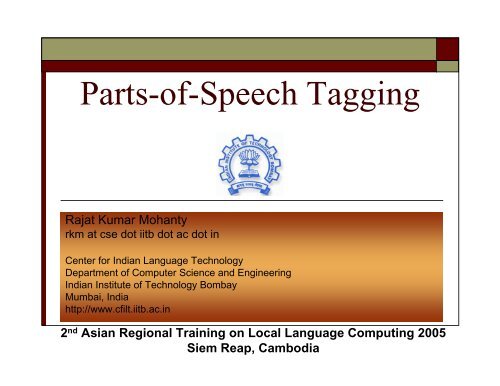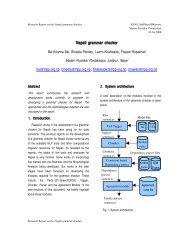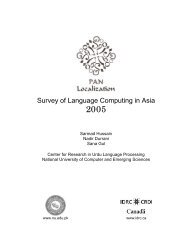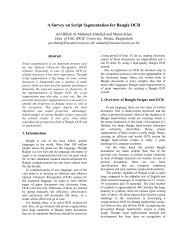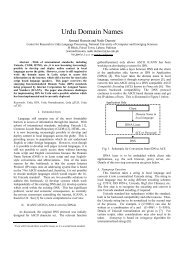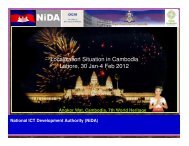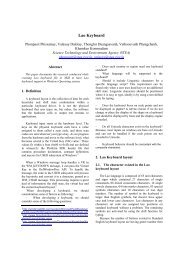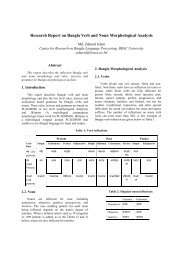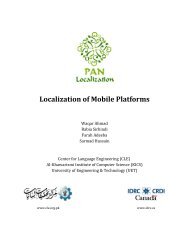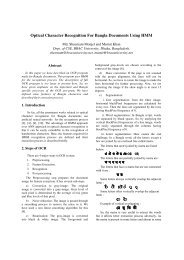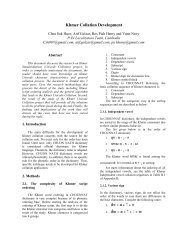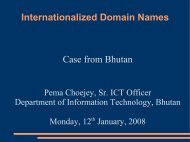POS Tagging and Corpus-Based Lexical ... - PAN Localization
POS Tagging and Corpus-Based Lexical ... - PAN Localization
POS Tagging and Corpus-Based Lexical ... - PAN Localization
Create successful ePaper yourself
Turn your PDF publications into a flip-book with our unique Google optimized e-Paper software.
Parts-of-Speech <strong>Tagging</strong><br />
Rajat Kumar Mohanty<br />
rkm at cse dot iitb dot ac dot in<br />
Center for Indian Language Technology<br />
Department of Computer Science <strong>and</strong> Engineering<br />
Indian Institute of Technology Bombay<br />
Mumbai, India<br />
http://www.cfilt.iitb.ac.in<br />
2 nd Asian Regional Training on Local Language Computing 2005<br />
Siem Reap, Cambodia
Introduction<br />
Thurseday, June 23, 2005 <strong>POS</strong> <strong>Tagging</strong> <strong>PAN</strong>LC 2005
An Ubiquitous Task<br />
<br />
<br />
Sequence labeling task can be at different levels.<br />
In written text<br />
• Words<br />
• Phrases<br />
• Sentences<br />
• Paragraphs<br />
Thurseday, June 23, 2005 <strong>POS</strong> <strong>Tagging</strong> <strong>PAN</strong>LC 2005
Names for Labeling Tasks<br />
Words: Part-of-Speech tagging / Named Entity<br />
tagging / Sense marking<br />
Phrases: Chunking<br />
Sentences: Parsing<br />
Paragraphs: Co-reference annotating<br />
Thurseday, June 23, 2005 <strong>POS</strong> <strong>Tagging</strong> <strong>PAN</strong>LC 2005
Example (Words: Parts-of-Speech <strong>Tagging</strong>)<br />
<br />
But they have to attract good senior bankers who can bring in the<br />
business from day one.<br />
<br />
<br />
But/CC [they/PRP] have/VBP to/TO attract/VB [good/JJ senior/JJ<br />
bankers/NNS ] [who/WP] can/MD bring/VB in/RP [the/DT<br />
business/NN] from/IN [day/NN one/CD] ./. <br />
Thurseday, June 23, 2005 <strong>POS</strong> <strong>Tagging</strong> <strong>PAN</strong>LC 2005
Roadmap<br />
<br />
<br />
<br />
<br />
<br />
<br />
<br />
<br />
<br />
Basic Idea of Parts-of-Speech <strong>Tagging</strong><br />
How hard is the Problem?<br />
Linguistic Input<br />
Issues in <strong>POS</strong> <strong>Tagging</strong><br />
Tagset Design<br />
Penn Treebank <strong>POS</strong> Tags<br />
Methods used to assign Tags<br />
• Rule-based<br />
• Stochastic<br />
Hindi <strong>POS</strong> Tagger<br />
• Morphological Analysis<br />
• <strong>POS</strong> <strong>Tagging</strong><br />
Conclusion<br />
Thurseday, June 23, 2005 <strong>POS</strong> <strong>Tagging</strong> <strong>PAN</strong>LC 2005
Basic Idea of <strong>POS</strong> <strong>Tagging</strong><br />
<br />
<br />
<br />
<br />
To assign an appropriate part of speech to a word in<br />
a sentence automatically (e.g., Noun, Verb,<br />
Adjective, Preposition, etc.)<br />
• INPUT: a string of words <strong>and</strong> a specified Tagset<br />
• OUTPUT: a single best tag for each word<br />
The first step in NLP at the sentence level<br />
Useful for many NLP tasks (such as parsing, WSD,<br />
etc.)<br />
Corpora with <strong>POS</strong> tagging: useful for linguistic<br />
research<br />
Thurseday, June 23, 2005 <strong>POS</strong> <strong>Tagging</strong> <strong>PAN</strong>LC 2005
How hard is the task?<br />
<br />
<br />
Is it possible to just look up the words in the<br />
dictionary?<br />
• Consider the English word ‘can’<br />
Is it really hard?<br />
• Ambiguity<br />
<br />
<br />
Does that flight serve dinner.<br />
I thought that your flight was late.<br />
Reported accuracy: about 99%<br />
Thurseday, June 23, 2005 <strong>POS</strong> <strong>Tagging</strong> <strong>PAN</strong>LC 2005
Linguistic Input: Parts of Speech (<strong>POS</strong>)<br />
<br />
<br />
<br />
<br />
Words are grouped together into classes (sets)<br />
which show similar syntactic behavior, often<br />
typical semantic type<br />
Syntactic or Grammatical categories<br />
Word categories are systematically related by<br />
morphological process<br />
Significant amount of information about the<br />
word <strong>and</strong> its neighbors<br />
Thurseday, June 23, 2005 <strong>POS</strong> <strong>Tagging</strong> <strong>PAN</strong>LC 2005
Significance of <strong>POS</strong><br />
<br />
<br />
<br />
Information about the word <strong>and</strong> its neighbors<br />
Many finer distinctions<br />
• Possessive pronouns (my, your, his, her, etc.)<br />
• Personal pronouns (I, you, he, she, etc.)<br />
Two broad subcategories<br />
• Closed class types (relatively fixed membership)<br />
• Open class types (N, V, Adj, Adv)<br />
Thurseday, June 23, 2005 <strong>POS</strong> <strong>Tagging</strong> <strong>PAN</strong>LC 2005
Closed Class Types<br />
• Determiners<br />
• Pronouns<br />
• Prepositions<br />
• Conjunctions<br />
• Auxiliaries<br />
• Particles<br />
• Numerals<br />
Thurseday, June 23, 2005 <strong>POS</strong> <strong>Tagging</strong> <strong>PAN</strong>LC 2005
Some Properties of the Closed Class Types<br />
<br />
<br />
Prepositions<br />
• They occur before NPs<br />
• Semantically relational<br />
• indicate spatial / temporal relations (other relation<br />
as well)<br />
Conjunctions<br />
• Join two phrases, clauses or sentences<br />
• Join two elements of equal status<br />
Thurseday, June 23, 2005 <strong>POS</strong> <strong>Tagging</strong> <strong>PAN</strong>LC 2005
Open Class Types<br />
<br />
<br />
<br />
<br />
Nouns (Common nouns, Eventive nouns, etc)<br />
Verbs (Intransitive, Transitive, Ditransitive, etc)<br />
Adjectives (attributive, predicative, etc)<br />
Adverbs (manner, degree, sentential, degree, etc)<br />
Thurseday, June 23, 2005 <strong>POS</strong> <strong>Tagging</strong> <strong>PAN</strong>LC 2005
Issues in <strong>POS</strong> <strong>Tagging</strong><br />
<br />
<br />
<br />
<br />
<br />
Tagset: The fundamental component<br />
Classification of words based on grammatical<br />
functions<br />
Multiple Tags (i.e., one morpheme indicates<br />
more than one functions )<br />
Multiple Words (i.e., two words indicate one<br />
function)<br />
Unknown Words<br />
Thurseday, June 23, 2005 <strong>POS</strong> <strong>Tagging</strong> <strong>PAN</strong>LC 2005
Tagset Design<br />
<br />
<br />
<br />
<br />
<br />
<br />
An appropriate set of Tags has direct influence on<br />
the accuracy <strong>and</strong> the usefulness of the tagging<br />
system.<br />
How much linguistic information expected from the<br />
Tagset?<br />
The larger the Tagset, the lower the accuracy<br />
The smaller the Tagset, the higher the accuracy<br />
The smallest Tagset, the least the usefulness<br />
Consistency<br />
Thurseday, June 23, 2005 <strong>POS</strong> <strong>Tagging</strong> <strong>PAN</strong>LC 2005
Some Tagsets<br />
Range from 40-200<br />
• London-Lund <strong>Corpus</strong> : 197 tags<br />
• Lancaster UCREL : 165 tags<br />
• LOB <strong>Corpus</strong> : 135 tags<br />
• Brown <strong>Corpus</strong> : 87 tags<br />
• CLAWS (BNC) : 61 (constituent likelihood<br />
automatic word-tagging system)<br />
• Penn <strong>POS</strong> Tagset: 48 (originally 87)<br />
Thurseday, June 23, 2005 <strong>POS</strong> <strong>Tagging</strong> <strong>PAN</strong>LC 2005
Penn Treebank <strong>POS</strong> Tags<br />
36 + 12<br />
1. CC Coordinating conjunction<br />
2. CD Cardinal number<br />
3. DT Determiner<br />
4. EX Existential there<br />
5. FW Foreign word<br />
6. IN Preposition or<br />
subordinating conjunction<br />
7. JJ Adjective<br />
8. JJR Adjective, comparative<br />
9. JJS Adjective, superlative<br />
10. LS List item marker<br />
11. MD Modal<br />
12. NN Noun, singular or mass<br />
13. NNS Noun, plural<br />
14. NNP Proper noun, singular<br />
15. NNPS Proper noun, plural<br />
16. PDT Predeterminer<br />
Thurseday, June 23, 2005 <strong>POS</strong> <strong>Tagging</strong> <strong>PAN</strong>LC 2005
Penn Treebank <strong>POS</strong> Tags<br />
17. <strong>POS</strong> Possessive ending<br />
18. PRP Personal pronoun<br />
19. PRP$ Possessive pronoun<br />
20. RB Adverb<br />
21. RBR Adverb, comparative<br />
22. RBS Adverb, superlative<br />
23. RP Particle<br />
24. SYM Symbol<br />
25. TO to<br />
26. UH Interjection<br />
27. VB Verb, base form<br />
Thurseday, June 23, 2005 <strong>POS</strong> <strong>Tagging</strong> <strong>PAN</strong>LC 2005<br />
28. VBD Verb, past tense<br />
29. VBG Verb, gerund or<br />
present participle<br />
30. VBN Verb, past participle<br />
31. VBP Verb, non-3rd<br />
person singular present<br />
32. VBZ Verb, 3rd person<br />
singular present<br />
33. WDT Wh-determiner<br />
34. WP Wh-pronoun<br />
35. WP$ Possessive wh-pronoun<br />
36. WRB Wh-adverb
Penn Treebank <strong>POS</strong> Tags<br />
37. # Pound sign<br />
38. $ Dollar sign<br />
39. . Sentence-final punctuation<br />
40. , Comma<br />
41. : Colon, semi-colon<br />
42. ( Left bracket character<br />
43. ) Right bracket character<br />
44. " Straight double quote<br />
45. ` Left open single quote<br />
46. " Left open double quote<br />
47. ' Right close single quote<br />
48. " Right close double quote<br />
Thurseday, June 23, 2005 <strong>POS</strong> <strong>Tagging</strong> <strong>PAN</strong>LC 2005
Penn <strong>POS</strong> Tags<br />
<br />
Official trading in the shares will start in Paris on<br />
Nov 6.<br />
[ Official/JJ trading/NN ]<br />
in/IN<br />
[ the/DT shares/NNS ]<br />
will/MD start/VB in/IN<br />
[ Paris/NNP ]<br />
on/IN<br />
[ Nov./NNP 6/CD ]<br />
[./.]<br />
Thurseday, June 23, 2005 <strong>POS</strong> <strong>Tagging</strong> <strong>PAN</strong>LC 2005
Verb forms in English<br />
Base<br />
VB<br />
-S<br />
VBZ<br />
Pres<br />
VBP<br />
Past<br />
VBD<br />
Pres_participle<br />
VBG<br />
Past_participle<br />
VBN<br />
Write<br />
Be<br />
Do<br />
Have<br />
writes<br />
is<br />
does<br />
has<br />
write<br />
am, are<br />
do<br />
have<br />
wrote<br />
was, were<br />
did<br />
had<br />
written<br />
been<br />
done<br />
had<br />
writing<br />
being<br />
doing<br />
having<br />
Thurseday, June 23, 2005 <strong>POS</strong> <strong>Tagging</strong> <strong>PAN</strong>LC 2005
Methods to Assign Tags<br />
Thurseday, June 23, 2005 <strong>POS</strong> <strong>Tagging</strong> <strong>PAN</strong>LC 2005
Methods to assign Tags<br />
<br />
Two common approaches<br />
• Rule-based<br />
• Stochastic<br />
<br />
Objectives<br />
• Need to be fast in order to process large corpora<br />
• To assign correct tags without actually<br />
parsing the sentence<br />
Thurseday, June 23, 2005 <strong>POS</strong> <strong>Tagging</strong> <strong>PAN</strong>LC 2005
Rule-<strong>Based</strong> Tagger<br />
<br />
<br />
Generally involves a large database of h<strong>and</strong>crafted<br />
disambiguation rules (Harris, 1962;<br />
Klein <strong>and</strong> Simmons, 1963; Green <strong>and</strong> Robin, 1971)<br />
<strong>Based</strong> on a two-stage architecture<br />
• The 1 st stage uses a dictionary to assign each<br />
word a list of potential <strong>POS</strong><br />
• The 2 nd stage uses a large list of h<strong>and</strong>-crafted<br />
disambiguation rules to winnow down this list to<br />
a single <strong>POS</strong> for each word<br />
Thurseday, June 23, 2005 <strong>POS</strong> <strong>Tagging</strong> <strong>PAN</strong>LC 2005
The ENGTWOL Tagger (Voutilainen, 1995)<br />
<br />
<br />
<br />
<br />
<br />
<strong>Based</strong> on the same two-stage architecture<br />
More sophisticated than the early algorithm<br />
<strong>Based</strong> on Two-level morphology<br />
1 st stage<br />
• each word is run through a two-level lexicon transducer<br />
• the entries for all possible <strong>POS</strong> are returned<br />
2 nd stage<br />
• about 1100 constraints are applied to the input sentences<br />
to rule out incorrect <strong>POS</strong><br />
Thurseday, June 23, 2005 <strong>POS</strong> <strong>Tagging</strong> <strong>PAN</strong>LC 2005
Examples<br />
<br />
<br />
<br />
The event was not that bad.<br />
• 1 st stage<br />
that ADV | PRON | DET | CS<br />
• 2 nd stage<br />
that ADV<br />
John had shown that salivation…<br />
• 1 st stage<br />
that ADV | PRON | DET | CS<br />
• 2 nd stage<br />
that CS<br />
I consider that odd.<br />
• 1 st stage<br />
that ADV | PRON | DET | CS<br />
• 2 nd stage<br />
that PRON<br />
Thurseday, June 23, 2005 <strong>POS</strong> <strong>Tagging</strong> <strong>PAN</strong>LC 2005
Adverbial-THAT Rule (informal)<br />
<br />
Given input “that”<br />
if<br />
<br />
<br />
<br />
then<br />
else<br />
<br />
the next word is an adjective/adverb #the event was not that bad.<br />
<strong>and</strong> the following is a sentence boundary<br />
the previous word is not a verb like believe or consider which<br />
allows a small clause<br />
eliminate non-ADV tags<br />
<br />
eliminate ADV tag<br />
Thurseday, June 23, 2005 <strong>POS</strong> <strong>Tagging</strong> <strong>PAN</strong>LC 2005
Complementizer-THAT Rule (informal)<br />
<br />
Given input “that”<br />
If<br />
<br />
<br />
then<br />
else<br />
<br />
<br />
the previous word is a verb which expects a complement (like<br />
think, show, know, etc)<br />
“that” is followed by the beginning of a noun phrase, <strong>and</strong> a finite<br />
verb<br />
eliminate non-CS tags<br />
eliminate CS tag<br />
Thurseday, June 23, 2005 <strong>POS</strong> <strong>Tagging</strong> <strong>PAN</strong>LC 2005
Stochastic Taggers<br />
<br />
<br />
<br />
<br />
Produce an often-reasonable output without seeming<br />
to know anything about the rules of a language<br />
Resolve <strong>Tagging</strong> ambiguities by using a trained<br />
corpus to compute the probability of a given word<br />
having a given tag in a given context<br />
Intuition behind all Stochastic taggers<br />
• Pick the most likely tag for this word<br />
A stochastic tagging algorithm: Hidden Markov<br />
Model (HMM)<br />
Thurseday, June 23, 2005 <strong>POS</strong> <strong>Tagging</strong> <strong>PAN</strong>LC 2005
Example<br />
<br />
<br />
<br />
<br />
Secretariat/NNP is/VBZ expected/VBN to/TO race/VB<br />
tomorrow/NN<br />
People/NNS continue/VBP to/TO inquire/VB the/DT<br />
reason/NN for/IN the/DT race/NN for/IN outer/JJ<br />
space/NN<br />
Consider the problem of assigning the appropriate tag to<br />
race<br />
Choose between NN <strong>and</strong> VB<br />
• to/TO race/???<br />
• The/DT race/???<br />
Thurseday, June 23, 2005 <strong>POS</strong> <strong>Tagging</strong> <strong>PAN</strong>LC 2005
Example<br />
<br />
<br />
<br />
<br />
<br />
<br />
Probabilities<br />
• P(VB|TO)P(race|VB)<br />
• P(NN|TO)P(race|NN)<br />
How likely are we to expect a verb or noun given the<br />
previous tag?<br />
They can just be computed from a corpus by<br />
counting <strong>and</strong> normalizing.<br />
A verb is more likely to follow TO than noun is.<br />
To run, to race, to eat<br />
Less common: walk to school<br />
Thurseday, June 23, 2005 <strong>POS</strong> <strong>Tagging</strong> <strong>PAN</strong>LC 2005
Brill’s Transformation-based Tagger<br />
<br />
<br />
<br />
<br />
Shares features of both tagging architectures<br />
<strong>Based</strong> on rules like a Rule-based Tagger<br />
Has a machine learning component, like a Stochastic<br />
Tagger<br />
• The rules are automatically induced from a previously<br />
tagged training corpus<br />
• Then the words are tagged following these rules<br />
Works by automatically recognizing <strong>and</strong> remedying<br />
its weaknesses, thereby incrementally improving its<br />
performance.<br />
Thurseday, June 23, 2005 <strong>POS</strong> <strong>Tagging</strong> <strong>PAN</strong>LC 2005
Transformation-based Rules<br />
<br />
<br />
<br />
<br />
Initially, the tagger assigns each word its the mostlikely<br />
tag<br />
The most-likely tag for race (in the Brown <strong>Corpus</strong>)<br />
• P(NN | race) = .98<br />
• P(VB | race) = .02<br />
Examples<br />
• … is/VBZ expected/VBN to/TO race/NN tomorrow/NN<br />
• the/DT race/NN for/IN outer/JJ space/NN<br />
After selecting the most-likely tag, the<br />
transformational rules are applied<br />
• Change NN to VB when the previous tag is TO<br />
Thurseday, June 23, 2005 <strong>POS</strong> <strong>Tagging</strong> <strong>PAN</strong>LC 2005
The Lexicon<br />
<br />
<br />
<br />
The most-likely tag is estimated by examining a<br />
large tagged corpus.<br />
In the Transformation-based tagger, the lexicon is<br />
simply a list of all tags seen for a word in the<br />
training corpus, with one tag labeled as the mostlikely.<br />
half: CD DT JJ NN PDT RB VB<br />
Thurseday, June 23, 2005 <strong>POS</strong> <strong>Tagging</strong> <strong>PAN</strong>LC 2005
Two Kinds of Rules<br />
<br />
<br />
Contextual Rules<br />
• Revise the tag of a particular word based on the context<br />
• NN VB PREVTAG TO<br />
• Change NN to VB when the previous tag is TO<br />
• to/TO race/NN to/TO race/VB<br />
<strong>Lexical</strong> Rules<br />
• Used to tag unknown words or words not found in the<br />
lexicon<br />
• NN s fhassuf NNS<br />
• Change NN to NNS if it has suffix –s<br />
• E.g., grapes<br />
Thurseday, June 23, 2005 <strong>POS</strong> <strong>Tagging</strong> <strong>PAN</strong>LC 2005
Patch Templates<br />
<br />
<br />
The tagger acquires patches to improve its<br />
performance.<br />
Patch templates are of the form:<br />
• If a word is tagged a <strong>and</strong> it is in context C, then change<br />
that tag to b, or<br />
• If a word is tagged a <strong>and</strong> it has lexical property P, then<br />
change that tag to b, or<br />
• If a word is tagged a <strong>and</strong> a word in region R has lexical<br />
property P, then change that tag to b.<br />
Thurseday, June 23, 2005 <strong>POS</strong> <strong>Tagging</strong> <strong>PAN</strong>LC 2005
The Transformation Templates (non-lexicalized)<br />
<br />
Change tag a to tag b when:<br />
(where a, b, z <strong>and</strong> w are variables over parts-of-speech)<br />
• The preceding (following) word is tagged z<br />
• The word two before (after) is tagged z<br />
• One of the two preceding (following) words is tagged z<br />
• One of the three preceding (following) words is tagged z<br />
• The preceding word is tagged z <strong>and</strong> the following word is<br />
tagged w<br />
• The preceding (following) word is tagged z <strong>and</strong> the word<br />
two before (after) is tagged z<br />
Thurseday, June 23, 2005 <strong>POS</strong> <strong>Tagging</strong> <strong>PAN</strong>LC 2005
Non-lexicalized Transformations<br />
<br />
Change tag<br />
From To Condition<br />
Example<br />
NN<br />
VBP<br />
VB<br />
VB<br />
Previous tag is TO<br />
One of the previous<br />
to race<br />
might not vanish<br />
three tags is MD<br />
NN VB One of the previous might not reply<br />
two tags is MD<br />
VB NN One of the previous the most recent match<br />
three tags is DT<br />
VBD VBN One of the previous …is frequently<br />
three tags is VBZ<br />
attacked<br />
Thurseday, June 23, 2005 <strong>POS</strong> <strong>Tagging</strong> <strong>PAN</strong>LC 2005
The Transformation Templates (lexicalized)<br />
<br />
Change tag a to tag b when:<br />
• The preceding (following) word is w<br />
• The word two before (after) is w<br />
• One of the two preceding (following) words is w<br />
• The current word is w <strong>and</strong> the preceding (following) words is x<br />
• The current word is w <strong>and</strong> the preceding (following) words is<br />
tagged z<br />
• The preceding (following) word is w <strong>and</strong> the preceding<br />
(following) tag is t<br />
• The current word is w, the preceding (following) word is w 2<br />
<strong>and</strong> the preceding (following) tag is t<br />
(where w <strong>and</strong> x are variables over all words in the training corpus, <strong>and</strong> a, b,<br />
<strong>and</strong> z are variables over parts-of-speech)<br />
Thurseday, June 23, 2005 <strong>POS</strong> <strong>Tagging</strong> <strong>PAN</strong>LC 2005
<strong>Lexical</strong>ized Transformations<br />
<br />
<br />
<br />
Learned from the trained WSJ <strong>Corpus</strong><br />
Change the tag:<br />
• From IN to RB if the word two positions to the right is as<br />
• From VBP to VB if one of the previous two words is n’t<br />
Examples:<br />
• as tall as<br />
• We didn’t usually drink<br />
Thurseday, June 23, 2005 <strong>POS</strong> <strong>Tagging</strong> <strong>PAN</strong>LC 2005
Transformations for Unknown Words<br />
<br />
<br />
<strong>Lexical</strong> Rules are used to tag unknown words<br />
Change the tag of an unknown word (from X) to Y if<br />
• Deleting the prefix (suffix) x, |x| = < 4, results in word (x<br />
is any string of length 1 to 4)<br />
• The first (last) (1,2,3,4) characters of the word are x<br />
• Adding the character string x as a prefix (suffix) results in<br />
a word (| x |
Transformations for Unknown Words<br />
<br />
Change Tag<br />
From To Condition<br />
NN NNS Has suffix -s<br />
NN CD Has character . or 0<br />
NN JJ Has suffix -al<br />
NN VBG Has suffix -ing<br />
NNS NN Has suffix -ss<br />
NN JJ Has suffix -ive<br />
NN JJ Has suffix -ble<br />
Example<br />
webpages<br />
3.5 or 30<br />
morphological<br />
tagging<br />
mass<br />
constructive<br />
readable<br />
Thurseday, June 23, 2005 <strong>POS</strong> <strong>Tagging</strong> <strong>PAN</strong>LC 2005
Transformation-<strong>Based</strong> Learning (TBL)<br />
<br />
<br />
Three major stages (of Brill’s TBL algorithm):<br />
• It labels every word with its most-likely tag.<br />
• It examines every possible transformation <strong>and</strong> selects the one<br />
that results in the most improved tagging.<br />
• It then re-tags the data according to the rules.<br />
TBL is a supervised learning technique; it assumes a<br />
pre-tagged training corpus.<br />
Thurseday, June 23, 2005 <strong>POS</strong> <strong>Tagging</strong> <strong>PAN</strong>LC 2005
Hindi <strong>POS</strong> Tagger<br />
Thurseday, June 23, 2005 <strong>POS</strong> <strong>Tagging</strong> <strong>PAN</strong>LC 2005
A Rule-based <strong>POS</strong> Tagger for Hindi<br />
<br />
<br />
<br />
<br />
Hindi: A morphologically rich Indian language<br />
A sophisticated Morphological Analyzer is<br />
embedded in the <strong>POS</strong> tagger<br />
At present 85 Tagsets<br />
The Tagsets are designed on the basis of<br />
morphological information, such as Person, Number,<br />
Gender, Tense, Aspect, Modality, Case, etc<br />
Thurseday, June 23, 2005 <strong>POS</strong> <strong>Tagging</strong> <strong>PAN</strong>LC 2005
Morphs <strong>and</strong> Morphemes<br />
Consider the word “accept”. If “accept” is a<br />
word, the following questions arise:<br />
Is “unacceptable” also a single word?<br />
Is “accept” in “unacceptable” a word<br />
within a word?<br />
The word unacceptable can be decomposed<br />
into three constituents:<br />
• un-, accept, -able.<br />
Thurseday, June 23, 2005 <strong>POS</strong> <strong>Tagging</strong> <strong>PAN</strong>LC 2005
Morphs <strong>and</strong> Morphemes<br />
The decomposed units of a word<br />
The minimal recurring units in the<br />
grammatical system of a language<br />
May not always be meaningful<br />
Examples:<br />
• Morph: /s, z, iz/<br />
• Morphemes: -s, -es (plural suffixes)<br />
Thurseday, June 23, 2005 <strong>POS</strong> <strong>Tagging</strong> <strong>PAN</strong>LC 2005
Types of Morphemes<br />
Morphemes<br />
Bound morpheme: Affix<br />
Free morphemes<br />
(e.g., book, pen)<br />
Concatenative<br />
Non-concatenative<br />
Prefix<br />
Infix<br />
Suffix<br />
Derivational<br />
Inflectional<br />
Derivational<br />
Class<br />
Class<br />
Class<br />
changing maintaining changing<br />
Thurseday, June 23, 2005 <strong>POS</strong> <strong>Tagging</strong> <strong>PAN</strong>LC 2005<br />
Class<br />
maintaining
Examples<br />
Free Morphemes<br />
• morphemes like “happy”, “regard”, etc can st<strong>and</strong> on their<br />
own as independent words<br />
Bound morphemes<br />
• morphemes like un-, dis-, etc cannot st<strong>and</strong> on their own as<br />
independent words<br />
Infix<br />
• lakad lumakad<br />
(walkwalked)<br />
Thurseday, June 23, 2005 <strong>POS</strong> <strong>Tagging</strong> <strong>PAN</strong>LC 2005
Stems <strong>and</strong> Affixes<br />
Morphemes like –s, un-, dis-, etc are called affixes<br />
(e.g., books, undesirable, dishonour)<br />
The form to which an affix is attached is called a<br />
stem. In the word “unhappy”, the affix is “un-” <strong>and</strong><br />
the stem is “happy”.<br />
Stems may also consist of a number of morphemes.<br />
Thurseday, June 23, 2005 <strong>POS</strong> <strong>Tagging</strong> <strong>PAN</strong>LC 2005
Affixation<br />
prefix<br />
unknowingly<br />
stem<br />
knowing<br />
Un-<br />
stem<br />
knowingly<br />
Derivational suffix<br />
-ly<br />
Stem (root)<br />
Inflectional suffix<br />
know<br />
-ing<br />
Thurseday, June 23, 2005 <strong>POS</strong> <strong>Tagging</strong> <strong>PAN</strong>LC 2005
Non-concatenative<br />
/kt5b/ ‘write’ (no category in Arabic)<br />
/ kAt5Ab/ ‘to write’<br />
/ kAAt5ib/ ‘wrote’<br />
/ kAt5t5ib/ ‘has written’<br />
/ Akt5Ub/ ‘will write’<br />
Thurseday, June 23, 2005 <strong>POS</strong> <strong>Tagging</strong> <strong>PAN</strong>LC 2005
Allomorphy<br />
Phonetically Conditioned /s, z, iz; d, t, id/<br />
(e.g., books, dogs, houses)<br />
Phonologically Conditioned<br />
• The choice of plural suffix solely depends on the pronunciation of the<br />
stem<br />
<strong>Lexical</strong>ly Conditioned<br />
• -en in oxen, -ren in children, -im in seraphim<br />
Grammatically Conditioned<br />
• Adjectives in German change their form depending on the gender of<br />
the noun they modify<br />
Thurseday, June 23, 2005 <strong>POS</strong> <strong>Tagging</strong> <strong>PAN</strong>LC 2005
Morphological Operations<br />
Inflection<br />
Derivation<br />
Compounding<br />
Feature Percolation<br />
Thurseday, June 23, 2005 <strong>POS</strong> <strong>Tagging</strong> <strong>PAN</strong>LC 2005
Inflection<br />
Inflectional morphology has certain characteristics<br />
• Systematic<br />
Adding a particular affix to a stem has the same grammatical or<br />
semantic effect for all stems<br />
• Productive<br />
New addition to the language automatically conform to the rules for<br />
affixation<br />
• Preservative<br />
The broad grammatical category of the word is not altered in the<br />
inflectional process<br />
Fix fixed<br />
Laugh laughing<br />
Thurseday, June 23, 2005 <strong>POS</strong> <strong>Tagging</strong> <strong>PAN</strong>LC 2005
Derivation<br />
Derivational Morphology has certain characteristics<br />
• Unsystematic<br />
Adding the same affix two different stems may have radically different<br />
semantic effects (e.g., criticise / localise)<br />
• Partly productive<br />
It would be misleading to say that new words in a language<br />
automatically undergo derivational process<br />
• Category alteration<br />
The category may or may not be unaltered (e.g., communism,<br />
brotherhood)<br />
Examples<br />
Form form + al Formal formal + ise<br />
Fix fix + able Organ organ + ic<br />
Thurseday, June 23, 2005 <strong>POS</strong> <strong>Tagging</strong> <strong>PAN</strong>LC 2005
Derivational Affixes<br />
Some examples from English<br />
• Nouns to nouns<br />
[ pref auto [ stem biography ] ]<br />
• Verb to verbs [ pref re [ stem try ]]<br />
• Adjective to adjectives [ pref sub [ stem human ]<br />
• Nouns to adjectives [ stem nation [ suff al ]<br />
• Verbs to nouns [ stem work [ suff er ]<br />
• Adjective to adverbs [ stem efficient [ suff ly ]<br />
Thurseday, June 23, 2005 <strong>POS</strong> <strong>Tagging</strong> <strong>PAN</strong>LC 2005
Compounding<br />
Some examples<br />
• Houseboat<br />
• Housewife<br />
• Blackboard<br />
• overflow<br />
Thurseday, June 23, 2005 <strong>POS</strong> <strong>Tagging</strong> <strong>PAN</strong>LC 2005
Feature Percolation Convention (FPC)<br />
Morphology is not a linear ordering of morphemes.<br />
Like syntax it has hierarchical organisation.<br />
The grammatical category of the word comes from<br />
the grammatical feature of the rightmost morpheme.<br />
adj<br />
[ un [health ] N y ] Adj<br />
Thurseday, June 23, 2005 <strong>POS</strong> <strong>Tagging</strong> <strong>PAN</strong>LC 2005
Feature Percolation Convention -1<br />
If a word is derived by an affix, the<br />
grammatical category of the affix is carried<br />
over to the derived word. E.g., dialectal<br />
adj<br />
[ [dialect ] N al ]<br />
Thurseday, June 23, 2005 <strong>POS</strong> <strong>Tagging</strong> <strong>PAN</strong>LC 2005
Feature Percolation Convention -2<br />
If a prefix does not have a grammatical feature<br />
of its own, then the derived word takes the<br />
feature of the immediate lower level. E.g.,<br />
undialectal<br />
adj<br />
[ un [dialect ] N al ] Adj<br />
Thurseday, June 23, 2005 <strong>POS</strong> <strong>Tagging</strong> <strong>PAN</strong>LC 2005
Productive Morphology<br />
Xerox n<br />
Xerox v<br />
Xeroxable adj<br />
unxeroxable adj<br />
Thurseday, June 23, 2005 <strong>POS</strong> <strong>Tagging</strong> <strong>PAN</strong>LC 2005
The Morphology-Syntax Interaction<br />
The form of a word gets affected by the<br />
syntactic construction<br />
Example: walk {walks, walk, walked}<br />
The selection of a particular form of this verb<br />
on a given occasion is dependent on the<br />
syntactic construction in which it appears.<br />
Thurseday, June 23, 2005 <strong>POS</strong> <strong>Tagging</strong> <strong>PAN</strong>LC 2005
Morphology <strong>and</strong> the Lexicon<br />
The relation between a word <strong>and</strong> its meaning is<br />
arbitrary<br />
The role of the lexicon is to list the meanings of<br />
words<br />
Morphosyntactic properties of a word must be stored<br />
in the lexicon (e.g., syntactic category, countable<br />
features, etc. )<br />
Many morphological problems involve the interaction<br />
between morphology <strong>and</strong> other modules of grammar<br />
Thurseday, June 23, 2005 <strong>POS</strong> <strong>Tagging</strong> <strong>PAN</strong>LC 2005
Morphological Analysis<br />
Two basic approaches: analysis <strong>and</strong> synthesis<br />
The analytic approach has to do with breaking words<br />
down<br />
The synthetic approach is how to put the pieces<br />
together<br />
In a sense, Analysis precedes synthesis<br />
A linguist needs both<br />
Thurseday, June 23, 2005 <strong>POS</strong> <strong>Tagging</strong> <strong>PAN</strong>LC 2005
Analytic Principles<br />
Principle 1<br />
• Forms with the same meaning <strong>and</strong> the same sound shape in<br />
all their occurrences are instances of the same morpheme<br />
Computerize<br />
Nationalize<br />
Modernize<br />
(-ize)<br />
(-ize)<br />
(-ize)<br />
Singing<br />
Writing<br />
Playing<br />
(-ing)<br />
(-ing)<br />
(-ing)<br />
Thurseday, June 23, 2005 <strong>POS</strong> <strong>Tagging</strong> <strong>PAN</strong>LC 2005
Analytic Principles<br />
Principle 2<br />
• Forms with the same meaning but different sound<br />
shapes may be instances of the same morpheme if<br />
their distributions do not overlap<br />
Seats<br />
Shades<br />
Houses<br />
Oxen<br />
/s/<br />
/z/<br />
/iz/<br />
/en/<br />
Thurseday, June 23, 2005 <strong>POS</strong> <strong>Tagging</strong> <strong>PAN</strong>LC 2005
Analytic Principles<br />
Principle 3<br />
• Not all morphemes are segmental<br />
Example (ablaut)<br />
• Run ran<br />
• Speak spoke<br />
• Eat ate<br />
Thurseday, June 23, 2005 <strong>POS</strong> <strong>Tagging</strong> <strong>PAN</strong>LC 2005
Analytic Principles<br />
Principle 4<br />
• A morpheme may have zero as one of its<br />
allomorphs provided it has a non-zero allomorph<br />
Fish (sg)<br />
fish (pl)<br />
Thurseday, June 23, 2005 <strong>POS</strong> <strong>Tagging</strong> <strong>PAN</strong>LC 2005
Morpheme Recognition<br />
Meaning of the affixes<br />
Function of the affixes<br />
Category of the root / stem<br />
Restriction of the root / stem<br />
Range of allomorphs<br />
Thurseday, June 23, 2005 <strong>POS</strong> <strong>Tagging</strong> <strong>PAN</strong>LC 2005
Morpheme Analysis<br />
DOs<br />
• Identify recurring forms<br />
• Match them with recurring meaning<br />
• Remember that a morpheme can have more than one form<br />
(allomorphs)<br />
DON’T assume that<br />
• The order of the morphemes are same as that of English<br />
• The semantic contrast is same as that of English<br />
Thurseday, June 23, 2005 <strong>POS</strong> <strong>Tagging</strong> <strong>PAN</strong>LC 2005
Morpheme Analysis: Examples<br />
<br />
Identify recurring forms <strong>and</strong> match them<br />
with recurring meanings. Consider the<br />
data from Turkish:<br />
[mumlar] “c<strong>and</strong>les”<br />
[toplar] “gums”<br />
[adamlar] “men”<br />
[kitaplar] “books”<br />
Thurseday, June 23, 2005 <strong>POS</strong> <strong>Tagging</strong> <strong>PAN</strong>LC 2005
Morpheme Analysis: Examples<br />
The form /lar/ occurs in all the four items in our<br />
sample data.<br />
From the English gloss of this data, we can see that<br />
the feature “plurality” is present in the meaning of all<br />
the four items.<br />
We can hypothesize that /lar/ is the morpheme<br />
making “plurality” in Turkish.<br />
Now we can infer that /mum/ in /mumlar/ is a<br />
morpheme which means “c<strong>and</strong>le”, <strong>and</strong> so on.<br />
Thurseday, June 23, 2005 <strong>POS</strong> <strong>Tagging</strong> <strong>PAN</strong>LC 2005
Morphology: Its Practical Relevance in NLP<br />
Smaller Dictionary<br />
Ease of entering data<br />
Neologism: Even if a word has not been seen<br />
before, it can be recognized<br />
Look-up: Simpler <strong>and</strong> faster look up process<br />
Thurseday, June 23, 2005 <strong>POS</strong> <strong>Tagging</strong> <strong>PAN</strong>LC 2005
Computational Issues<br />
Segmentation <strong>and</strong> Grapheme<br />
• Segmentation cannot be done simply by spotting a<br />
familiar affix <strong>and</strong> detaching it (e.g., thing, read,<br />
etc)<br />
Graphotactics<br />
• Deletion<br />
• Insertion<br />
(e.g., love + ed = loved)<br />
(e.g., church + s = churches)<br />
• Transformation (e.g., fly + s = flies)<br />
Thurseday, June 23, 2005 <strong>POS</strong> <strong>Tagging</strong> <strong>PAN</strong>LC 2005
Morphological Parsing with Shoebox<br />
Lexicon<br />
/ lx<br />
/ ps<br />
/ ge<br />
un-<br />
OP<strong>POS</strong>neg<br />
/ lx<br />
/ ps<br />
/ ge<br />
success<br />
achievement<br />
n<br />
/ lx<br />
/ ps<br />
/ ge<br />
-ful<br />
ADJVZR<br />
-nadjzr<br />
Parse<br />
/ t<br />
/ m<br />
/ ge<br />
/ ps<br />
unsuccessful<br />
un- success -ful<br />
OP<strong>POS</strong> achievement ADJVZR<br />
neg<br />
n<br />
-nadjzr<br />
Thurseday, June 23, 2005 <strong>POS</strong> <strong>Tagging</strong> <strong>PAN</strong>LC 2005
Sample Hindi Morphological Analysis<br />
/a:/ S-type Aspect | GNR | Causative | deverbal<br />
/i:/ GNR<br />
/cuk/ V-type Aspect <br />
/kar/ Habitual Aspect<br />
/la/ Inceptive Aspect<br />
/rah/ Imperfective Aspect<br />
/h/ Copula (non-past) /t/ Copula (past)<br />
/p/ Modal<br />
/wal/ Nominalizer<br />
// | /o/ | /i/ Plural number<br />
// | // | // Person Number<br />
/sk/ Modal <br />
/jie/ | /ie/ Modal <br />
// Tense<br />
Thurseday, June 23, 2005 <strong>POS</strong> <strong>Tagging</strong> <strong>PAN</strong>LC 2005
Underlying Representation of Hindi VGs<br />
V >MOD >ASP >GNR >ASP >GNR >MOD >ASP >GNR >COP >SJ>PN >F >GNR<br />
ba> [] >n > e > [] >[] >[] >l > a: > h >[] > >[] >[]<br />
ba> pa:>[] > [] > rh > a: >[] >[] > [] > h >[] >u >[] >[]<br />
ba> pa:>t > a: > rh > a: >[] >[] > [] > h >o > > >a:<br />
ka:> [] > n > i: > [] >[] > pÍ>[] > ti > h >o > > >i:<br />
Thurseday, June 23, 2005 <strong>POS</strong> <strong>Tagging</strong> <strong>PAN</strong>LC 2005
Shoebox<br />
<br />
Demo<br />
Thurseday, June 23, 2005 <strong>POS</strong> <strong>Tagging</strong> <strong>PAN</strong>LC 2005
Hindi <strong>POS</strong> Tagger (Shrivastava et.al., 2005)<br />
Input<br />
Stemmer<br />
Root, suffix, <strong>POS</strong> category<br />
Suffix Analyzer<br />
Feature Information<br />
Disambiguator<br />
Final Analysis<br />
Morphological<br />
Analyzer<br />
Tagger<br />
Tag Generation<br />
Tagged Output<br />
Thurseday, June 23, 2005 <strong>POS</strong> <strong>Tagging</strong> <strong>PAN</strong>LC 2005
PNGTAM information in Hindi Verbs<br />
<br />
<br />
<br />
<br />
PNG Features<br />
Tense: Past, Present, Future<br />
Aspect<br />
• Situation type Aspects: Perfective, Imperfective,<br />
etc<br />
• View-point type Aspects: Durative, Inceptive, etc<br />
Modality: deontic, abilitive, permissive, requestive,<br />
etc.<br />
Thurseday, June 23, 2005 <strong>POS</strong> <strong>Tagging</strong> <strong>PAN</strong>LC 2005
Examples<br />
ghÅrmE /N_LOC<br />
house-LOC<br />
rÅht5ahE /VB_PRS_3_SG_M<br />
stay–M-COP-PRES-3sg<br />
skul /N<br />
school<br />
æa: /VB<br />
go<br />
rÅha:hE /PRS_DUR_3_SG_M<br />
ASP DUR –M-COP-PRES-3sg<br />
t5ÅkHa) /N<br />
money<br />
bHa:g /VB<br />
run<br />
pa:t5a:hu) /VB_PRS_1_SG_M<br />
get-M-COP-PRES-1sg<br />
pa:t5ahu) /PRS_ABL_1_SG_M<br />
ASP ABL -M-COP-PRES-1sg<br />
Thurseday, June 23, 2005 <strong>POS</strong> <strong>Tagging</strong> <strong>PAN</strong>LC 2005
Conclusion<br />
<br />
<br />
<br />
<br />
<br />
<br />
A Rule-based <strong>POS</strong> Tagger for Hindi is under development at<br />
CFILT, IIT Bombay.<br />
Much importance is being given to Morphological Analysis.<br />
We started our work with the use of The Linguist’s<br />
Shoebox/Toolbox (http://www.sil.org/computing/shoebox) to acquire<br />
the necessary morphological information from the corpus.<br />
Morphological Information is being used for disambiguation.<br />
We are also working on Marathi <strong>and</strong> Oriya <strong>POS</strong> Tagger.<br />
The same model is likely to be applied to other Indian<br />
Languages shortly.<br />
Thurseday, June 23, 2005 <strong>POS</strong> <strong>Tagging</strong> <strong>PAN</strong>LC 2005
Sources <strong>and</strong> Suggested Readings<br />
<br />
<br />
<br />
<br />
<br />
Allen, J. 2004. Natural Language Underst<strong>and</strong>ing. Person<br />
Education, Singapore.<br />
Brill, E. 1992. A simple rule-based part-of-speech tagger. In<br />
Proceedings of the Third Conference on Applied Natural<br />
Language Processing, Italy.<br />
Brill, E. 1995. Transformation-<strong>Based</strong> Error-Driven Learning<br />
<strong>and</strong> Natural Language Processing: A Case Study in Parts-of-<br />
Speech <strong>Tagging</strong>. Computational Linguistics, 21-4.<br />
Brill, E. 1997. Unsupervised learning of Disambiguation<br />
Rules for Parts-of-Speech <strong>Tagging</strong>. In Natural Language<br />
Processing Using very Large Corpora. Kluwer Academic<br />
Press.<br />
Charniak, E. 1993. Statistical Language Learning. The MIT<br />
Press, Cambridge.<br />
Thurseday, June 23, 2005 <strong>POS</strong> <strong>Tagging</strong> <strong>PAN</strong>LC 2005
Sources <strong>and</strong> Suggested Readings<br />
Harris, Z. 1962. String Analysis of Language Structure.<br />
Mouton <strong>and</strong> Co, The Hague.<br />
Jurafsky, D. <strong>and</strong> J. H. Martin. 2000. Speech <strong>and</strong> Language<br />
Processing. Prentice-Hall, New Jersy.<br />
Mahapatra, B. B. 2004. Hindi Verb Morphology. Ms. CFILT,<br />
IITB, INDIA.<br />
Manning, C. D. <strong>and</strong> H. Schiitze. 2002. Foundations of<br />
Statistical Natural Language Processing. The MIT Press.<br />
Marcus, M. P., B. Santorini, <strong>and</strong> M. A. Marcinkiewicz. 1993.<br />
Building a large annotated corpus in English: The Penn<br />
Treebank. Computational Linguistics, 19-2.<br />
Thurseday, June 23, 2005 <strong>POS</strong> <strong>Tagging</strong> <strong>PAN</strong>LC 2005
Sources <strong>and</strong> Suggested Readings<br />
Shrivastava, M, B. B. Mahaptra, N. Agarwal, S. Sing, P.<br />
Bhattacharya. 2005. Morphology-based Natural Language<br />
Processing Tools for Indian Languages. Morphology<br />
Workshop, CFILT, IIT Bombay, INDIA.<br />
Voutilainen, A. 1995. The ENGTWOL Tagger.<br />
http://www.lingsoft.fi/doc/engcg/intro/<br />
Aronoff, Mark. 2005. What is Morphology?. Blackwell. UK.<br />
Katamba, Francis.1993. Morphology. Macmillan.<br />
Sengupta, Gautam. 1997. Three Models of Morphological<br />
Processing. South Asian Language Review, Vol-vii, 1997.<br />
Nida, Eugene. 1965. Morphology.<br />
Thurseday, June 23, 2005 <strong>POS</strong> <strong>Tagging</strong> <strong>PAN</strong>LC 2005
Thank You<br />
Thurseday, June 23, 2005 <strong>POS</strong> <strong>Tagging</strong> <strong>PAN</strong>LC 2005


